HOW MUCH DOES AN ADJUSTABLE CLIMBING WALL COST?
There is no doubt that the purchase of an adjustable climbing wall can be significant, whether it is for a homeowner installing a 7' wide wall in their garage, a gym installing a new workout facility, or a shopping centre purchasing a set of 3 adjustable push button walls. While the question of cost may seem simple, the answer varies greatly depending on the options chosen.
Let's break it down first - a climbing wall is not a complete product, it requires climbing holds and also protective mats or a belay system. Often, for a normal climbing gym to be installed, it is necessary to make some adjustments to the building to support the walls, which can add huge costs. Then, to make the wall adjustable, an adjustment system is needed which adds to the complexity.
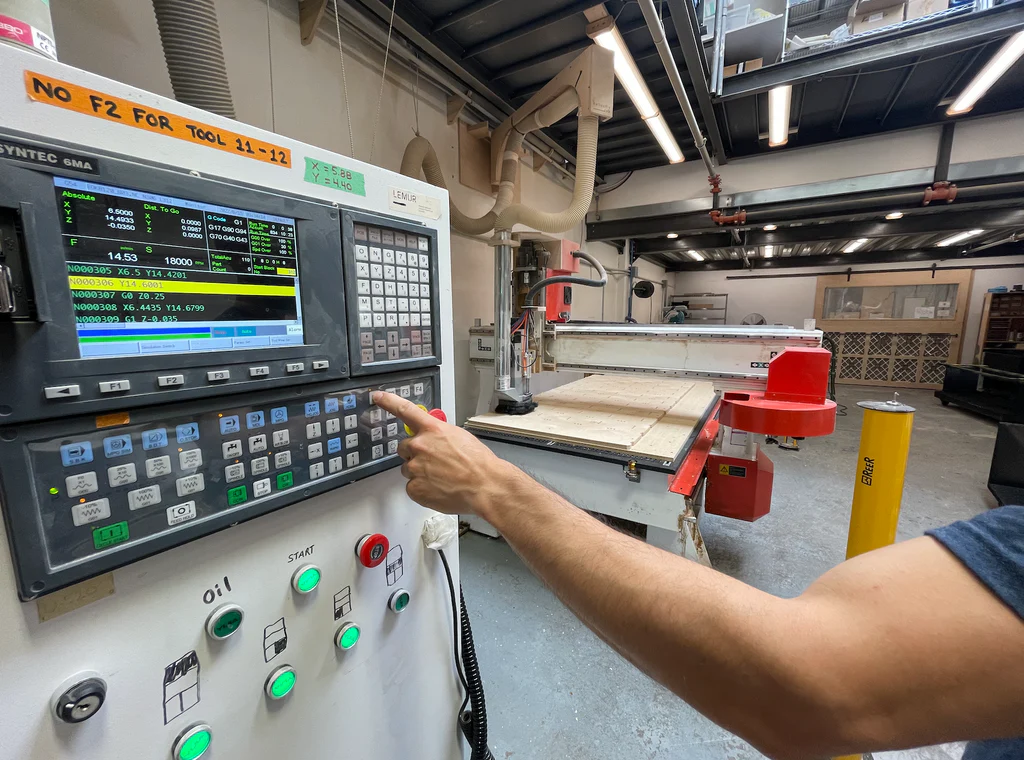 A LEMUR employee activating a CNC machine to cut a panel with precision.
A LEMUR employee activating a CNC machine to cut a panel with precision.
DO IT YOURSELF OR USE A PROFESSIONAL WALL?
Making an adjustable climbing wall is not rocket science: many DIYers will be able to build a very basic, but "good enough" home-made system with little effort and at a much lower cost than a professional option. A simple adjustable wall with a chain hoist can cost you less than $2,000, but these DIY constructions are often not suitable for commercial applications and this low cost does not include the important additions of climbing holds and mats. It is also worth mentioning that insurance can be an issue with these types of walls.
At the other end of the spectrum, you can have a specialist company like LEMUR Design design a custom adjustable climbing wall for your needs and space. This is a great option for special installations or specific needs, but designing, engineering and producing a 100% custom product can be a slow process and result in bills of over $75,000, so it's not the best solution for everyone.
The best option for most situations will be LEMUR's adjustable freestanding climbing walls - a high quality "plug and play" solution that does not require complex installation or support structures, can be set up and moved quite easily, is adjusted with a simple electronic button and looks fantastic!
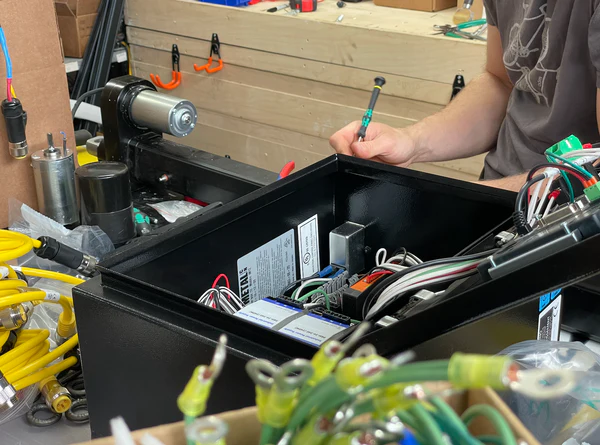 Research and development is important for quality products, but also influences the price. Here a LEMUR employee testing new electronic components.
Research and development is important for quality products, but also influences the price. Here a LEMUR employee testing new electronic components.
WHAT MAKES A CLIMBING WALL ADJUSTABLE?
To be considered an adjustable wall, the climbing wall must offer the user the ability to change the angle of the wall with minimal effort. The wall shall be equipped with an adjustment system to change the angle and a support system to keep the wall stable at each angle at which it is stopped.
The simplest adjustment systems require the removal of a screw or pin before moving the wall with a manual or electric hoist. Some systems compensate the weight of the wall by various means (gas spring, counterweight, central pivot, etc.) and secure it with basic technology such as adjustable chains with clips. These systems may be suitable for domestic use but, depending on their construction and complexity, they are not always suitable for customer use. In general, an automated system is a better choice for gymnasiums and public use facilities.
Commercial gyms often opt for fully automated climbing walls with electric actuators and control boxes that allow the client to push a button and move the wall effortlessly. This is the safest and most user-friendly way to have an adjustable wall in a gym.
All these systems have a cost. From the cheapest manual spindle adjustment systems, to several thousand dollars for high quality electric or hydraulic jack systems. Consider who will be moving the wall and how often it will be moved when deciding on the best solution for your installation. Remember, the more quickly and easily the wall can adjust its angles, the more you can use the space for as many users as possible!
WHAT SIZES ARE AVAILABLE AND HOW DOES THIS AFFECT THE AFFECT THE PRICE?
The development of commercial adjustable climbing walls is relatively recent. Market players have worked hard to expand their range and the options available. Nevertheless, grip systems such as the Kilterboard and Moonboard have set very clear dimensional standards in recent years. The maximum size of a Moonboard is 8'x12' and this is a very common size for gyms and individuals. The Kilterboard system, on the other hand, offers its system up to 12'x12', a size now seen in gyms around the world. The Covid 19 pandemic has forced many climbers to equip themselves at home, and not all climbers have a double height garage. In response to this demand, new 7x10 and 10x10 home adjustable wall sizes have come onto the market and have quickly become very popular.
The price varies according to the surface of the wall and should be fairly consistent in terms of features, quality and value between wall and holds manufacturers.
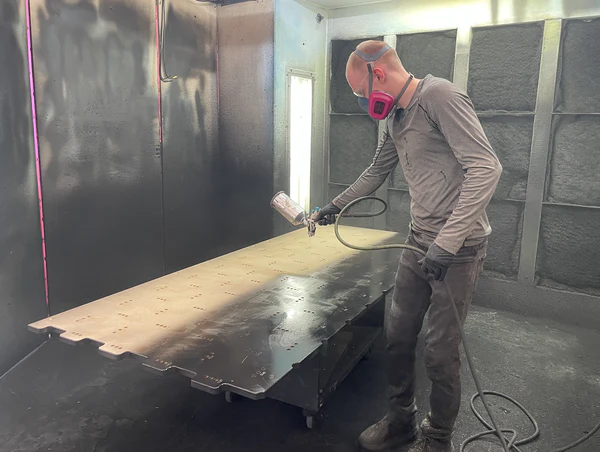 A LEMUR employee applies a first coat of paint, a secret and more durable mixture developed in Montreal.
A LEMUR employee applies a first coat of paint, a secret and more durable mixture developed in Montreal.
WHAT DOES "SELF-SUPPORTING" MEAN?
The term "self-supporting" means that the wall stands on its own, i.e. no other structure is needed to support the wall apart from the ground on which it stands. Self-supporting walls have a very clean and modern look.
Making such a wall is not easy, as the safety of the product depends on the manufacturer's calculations. Often a stronger structure is needed for the self-supporting frame to get rid of the ground anchors or a supporting wall behind. These freestanding frames are therefore a little more complex and can be more expensive than a simple bolted frame, but they require less support from the space in which they are installed and can be more easily moved or removed to meet customer needs. Instead of having to hire an engineer to look at your support walls, you can simply build your freestanding walls on any flat ground and start climbing!
IF IT IS EXPENSIVE, CAN WE EXPECT A RETURN ON INVESTMENT FOR OUR CENTRE? FOR OUR CENTRE?
Obviously, an investment as large as an adjustable wall requires that you get a return. While most of our customers will tell you that they do and that they have obtained great value from their adjustable walls, it is important that each climbing gym considers its clientele and makes the right choices.
If your climbing gym is already full every night, do you need to invest more? The answer is yes, of course. Continuing to invest in your gym shows your customers that you care about their experience.
An established clientele who climb regularly will be just as happy with an adjustable wall as new climbers who visit your gym to try climbing for the first time. Adjustable angles allow climbers to tailor the difficulty to their needs, so everyone can enjoy the adjustable wall you have invested in. Adjustability multiplies the amount of wall you get for your investment and your space - for example, a standard LEMUR frame adjusts from 0º vertical to 70º overhanging - that's 71 angles if you go by degrees, or 15 angles if you go in 5º increments.
In addition to the benefits of the adjustable angle, having an application supported system exponentially increases the number of climbing routes your clients can access in any given session. The Kilter Board system alone has over 60,000 problems in its database. 60,000 boulders x 15 angles = 900,000 climbs to try! Can you say the same about your bouldering room? And database-driven systems like the Kilter Board mean your climbers are connected to a wider community, allowing them to climb and train with other climbers from around the world, from new climbers to professional athletes.
In addition to open climbing hours, many gyms use their adjustable walls for teams, programs, clinics, para-climbing groups, ice climbing training (with wood/rubber tipped ice tools) and community events such as night climbing and competitions.
We asked two of our customers what they thought of their investment in an adjustable climbing wall, and you can see their answers here on Vertige Climbing and the Beta Bloc who have installed an adjustable Kilterboard on a LEMUR Design wall.
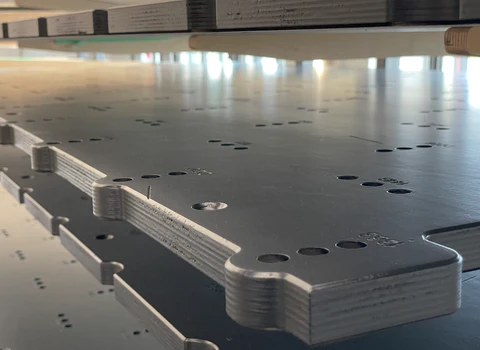 A finished panel after drying, with pre-drilled holes for Kilter Board climbing holds and LED lights.
A finished panel after drying, with pre-drilled holes for Kilter Board climbing holds and LED lights.
AND FINALLY, HOW MUCH DOES IT COST?
Adjustable "Do It Yourself" wall
Between 500 and 2000 dollars, knowing that the labour is free!
Small, manually adjustable wall
Between 4,000 and 12,000 dollars. A single wall produced near you will be your best option.
Automatically adjustable wall, larger
Between $15,000 and $50,000. Size will be the most influential factor, as well as installation costs. Many customers prefer to do the installation themselves while others opt for an included installation package, which can add between $7,000 and $15,000 depending on the destination. These larger walls open the door to the installation of the most advanced systems such as Kilterboard.
HOW MUCH DO CLIMBING HOLDS COST?
Up to $15,000, although you can usually get a decent house wall for a few thousand dollars.
The cheapest option for home users: old/used and homemade. Your local gym may sell old holds from time to time, or you can sometimes find offers from large and small holds manufacturers on the internet. You can also try making your own holds from wood or other materials. The DIY hold group on facebook can be a good source of information about this.
For the luxury home and for sports/commercial rooms: If you want a system with LEDs and a standardised hold layout, expect to pay around $3,000 minimum. If you just want a Kilter Board, the best system on the market, prices start at $3400 for a 7x10 Home Wall system and go up to over $10,000 for the Original 12x12 Kilter Board system (most common in gyms). There are other Kilter Board sizes and options in between for most spaces and budgets.
DO I NEED A FLOOR WITH A MATTRESS?
Yes, in climbing, you have to plan for falls! If you are building a small, simple wall, you can make do with a few outdoor crash pads. These are designed to break a fall and are easy to move and store, but they tend to slip and create gaps. At the other end of the spectrum, you can opt for a custom padded floor, printed with your brand name, which can cost you up to $15,000. In between, there are many options for both the home and the gym, so get quotes for your project!
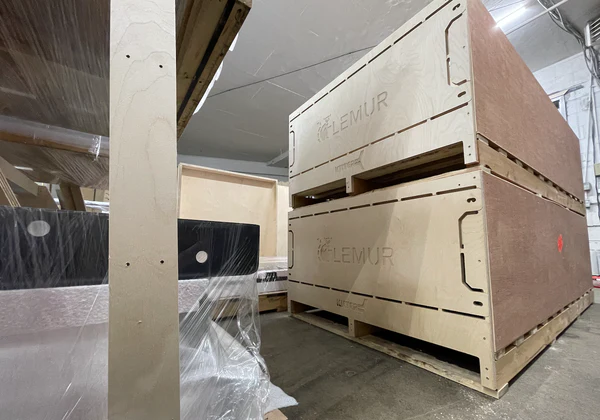 Two LEMUR adjustable climbing walls in their transport boxes, ready to go to Europe and Asia.
Two LEMUR adjustable climbing walls in their transport boxes, ready to go to Europe and Asia.
IN SUMMARY
Type of wall | Wall price | Price of climbing holds (Kilterboard or other) | Mattress prices |
|---|---|---|---|
Do it yourself | $500$ - $2000 | 200 and up - Used outlets $1500 - $7000 - New spray wall $4000 to $12,000 - Drive hold system + LED | $500-$1,000 Crash Pads $2,000-$8,000+ Custom mattresses for homes |
Adjustable house wall | $6000 - $11,000 | $2000+ New spray wall plugs $4000-$12,000 Drive hold system + LED | $2,000-$10,000+ Smaller commercial mattresses |
Automatically adjustable training wall, such as 8x12-10x12- 12x12-16x14 foot | $21,000 - $35,000 | $3000+ for a wall full of new holds 3400 - $15,000 Drive system + LED and app such as Kilter Board | $4,000 - $12,000+ Larger commercial mattress |
Adjustable bouldering wall, up to 24x14 feet | $22,000 - $44,000+ | $3000-$15000+ for a wall full of new holds | $4,000 - $12,000+ Larger commercial mattress $6,000 - $15,000+ Commercial Custom Mattresses |
NOTE: Amounts are ranges expressed in $USD, shipping and installation not included. LEMUR Design and other suppliers reserve the right to change prices without notice as the current supply market is volatile. Request a quote or speak to a member of our team to make the best choice for your situation.